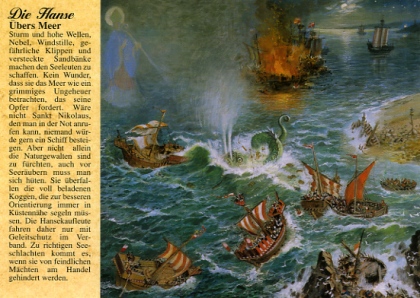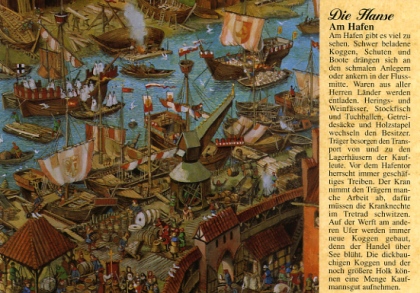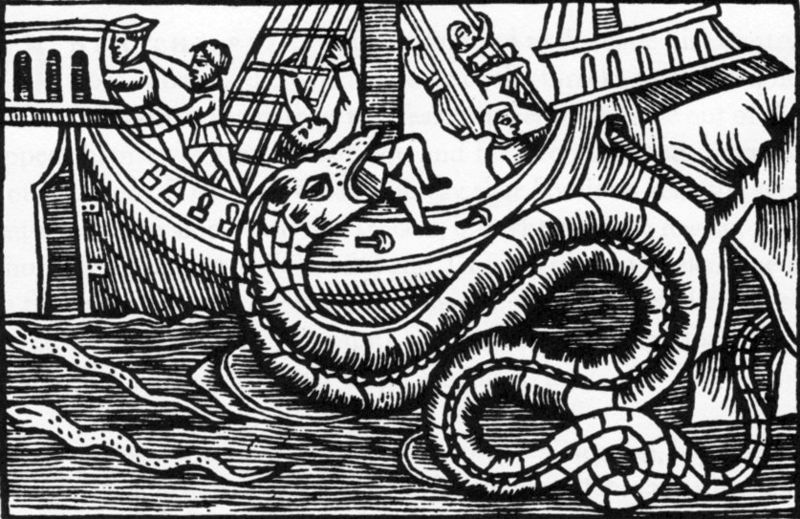Filed under: general
 There’s a board game called Hansa, in which you are a merchant sailing the Baltic trying to set up markets and sell things. You can play it online at the designer Michael Schacht’s website.
There’s a board game called Hansa, in which you are a merchant sailing the Baltic trying to set up markets and sell things. You can play it online at the designer Michael Schacht’s website.
There’s also an online quiz – I scored 17/20.
Hamburg was one of the founding members of the Hansa, and its trade alliance with Lübeck in 1241 formed the core of the League. Trade naturally centred around the harbour, which lay on the trade routes of the North and Baltic Seas and also provided access via the Elbe river to the towns and villages of the interior, including the Altmarkt.
The harbour is now the second largest in Europe (after Rotterdam – not a Hansestadt!). The Hafengeburtstag is celebrated every year; in 2009 it will be 810 years old, and the party is 8-10 May.



Brugge was chartered in 1127; its harbour was established at Damme. Brugge in particular traded cloth with England and Scotland, France, Italy and other parts of the Mediterranean. A Kontor (trading post) was established at Brugge, but from the middle of the 15th century, Hanseatic trade began to slip away, and the Kontor moved to Antwerp, eventually closing in 1593.


Stockholm, founded in the 13th century, was a key city in the Hansa and rose to prominence on the strength of the Baltic trade. The Hansa also dominated the city council during the 14th and 15th centuries.

Lübeck, the Queen of the Hansa, was where it all started. Prior to the establishment of the League, Saxon traders used the city as a base for their trade to Scandinavia and the Eastern Baltic. Lübeck formed an alliance in 1241 with Hamburg and later with Cologne, challenged Scandinavian dominance of the Baltic, established colonies in England, Livonia and Russia, and became the dominant city of the League, hosting the first General Diet of the Hansa in 1356.
These splendid cards came from Rainer. The first, of the Holstentor, is Torsten Krüger; the others, by Thomas Radbruch, are of Mengestraße, Wahmstraße, Puppenbrücke and Glandorpshof.
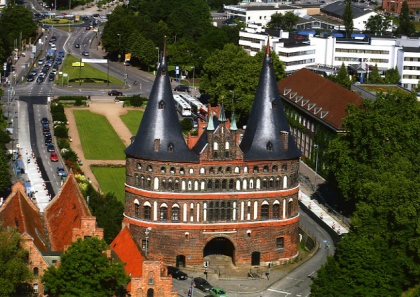
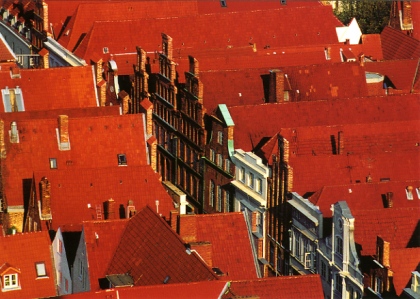

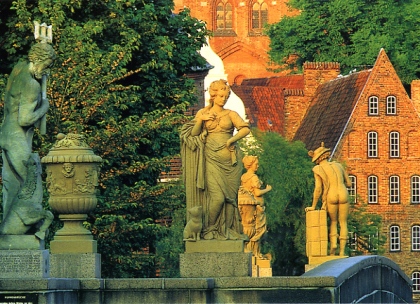
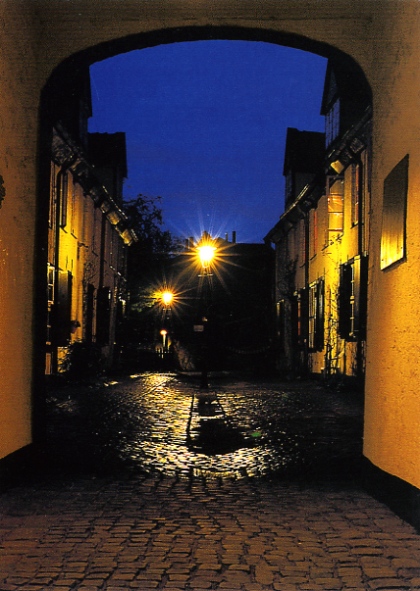
Hanseatic issues don’t feature very prominantly in the history of Ipswich, but it did have a Hansa subsidiary Kontore, under the control of the Steelyard Hansa in London. Margaret, Postcard Queen of Ipswich, kindly sent these very appropriate cards.

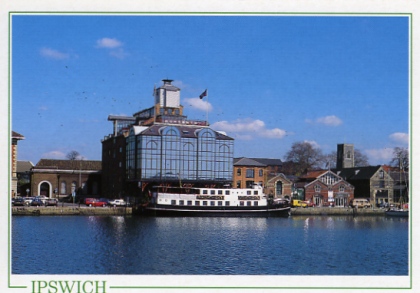

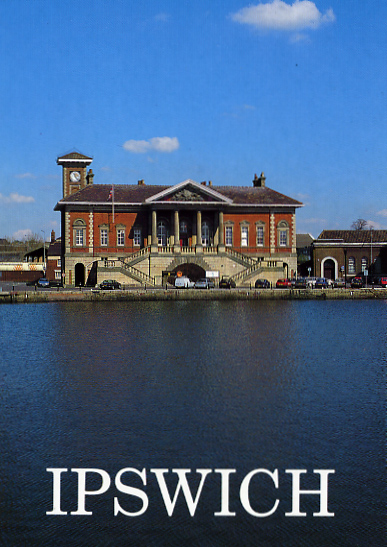
An article entitled The Hansa League, by Helen Zimmern, appeared in the New York Times in October 1889. This is an extract; I make no comment about its reliability.
Edward III pawned his jewels to the Cologne merchants. When the time came to pay his advances, by the failure of the Bardi, it was found the King had brought about the Florentine bankers’ ruin, being their debtor for a million of golden gulden. Edward was sore in need of money to fight France with. The League behaved handsomely, for the King drew on them for £30,000, “a sum worth fifteen times more then than today.” Crecy and Poitiers were won by the Black Prince, and it was the Hanse merchants who paid the piper. A German had let to him in return the tin mines belonging to the Black Prince in Cornwall. There were farms too in England ceded to Germans for a thousand years.
The sturdy Englishman of the people did not love the Hansa. Wat Tyler’s mob pursued the Germans, and woe to any one who could not pronounce “bread and cheese”; for a mispronunciation he was murdered.
But the League bided its time, and in London, first at Guildhall and then at Easterling’s Hall, and finally at the Steelyard, it held its sway in England. It had the key to the whole commerce fo the city of London and dominated the situation. The Steelyard had rules, laws and regulations of its own. It was a German unit in the middle of England. It was liberal in a certain way and gave handsomely to the city of London and it probably bribed many officials. It bought wool, corn, beer, and cheese, and imported iron utensils, flax, linen, hempen goods, fish and wines. It worked in from its southern correspondents the luxuries, as spices, perfumes, medicines, figs, almonds, dates, gold dust and jewels. It even traded in falcons, which were brought from Norway and Livonia.
London was the main depot, but there were branch factories at York, Hull, Bristol, Norwich, Ipswich, Yarmoth, Boston and Lynn Regis [King’s Lynn].
Narva in the far east of Estonia, on the Baltic and the Russian border, had, like many cities in Livonia, a Hanse community and in the 14th century became a member of the Hanseatic League, on the trade routes to and from Russia.
The card, from Jarek, shows Hermann Castle, founded as a wooden fortress in 1256 by the Danes, first built in stone in the early 14th century, and sold to the Teutonic knights in 1346, who rebuilt it too. The city was largely destroyed in WW2.

Stralsund, in Mecklenburg-Vorpommern and on the Stralesund (the Baltic sound between the mainland and the island of Rügen), was a rival to Lübeck and became a Hansestadt in 1293. According to Wikipedia there were 300 ships sailing out of Stralsund in the 14th century.
Stralsund and Wismar joined the UNESCO list of world heritage sites in 2002. The website is here.
The cards are from Sabine:

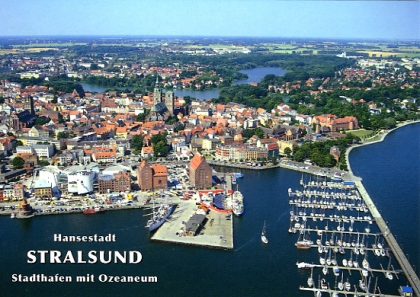


Filed under: germany | Tags: gardelegen, havelberg, osterburg, salzwedel, seehausen, stendal, tangermünde, werben
An official postcrossing card (DE-245181) from Kai… eight with one blow. The Altmark is a rural district north of Magdeburg in the Bundesland Sachsen-Anhalt. It’s bounded by the Elbe which flows to Hamburg.
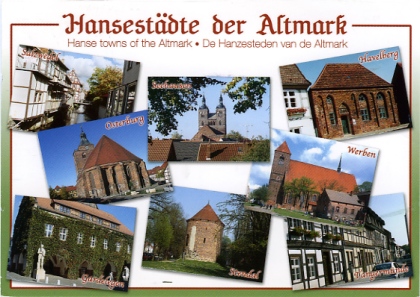
Salzwedel, Osterburg, Seehausen, Havelberg, Werben, Gardelegen, Stendal and Tangermuende. Thank you Kai!
Filed under: general
The rest of the set from Claus (see below – pictures by Heinz-Joachim Draeger, © Convent Verlag, Hamburg), showing now a representative Hansestadt, the city gate, the streets, market, church-raising and a typical merchant’s house. Thank you Claus!

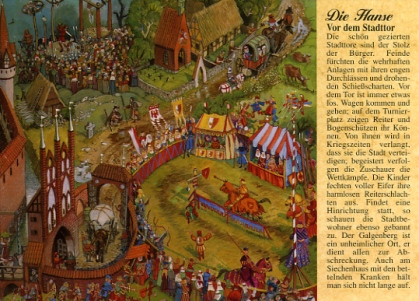



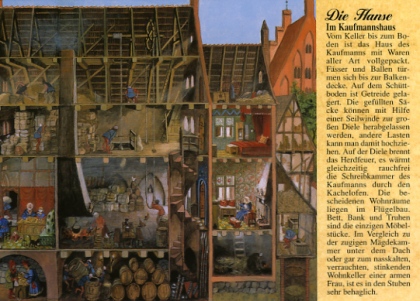
Filed under: general
Might as well begin with a lovely set of cards from Claus, giving (in German) the history of the Hanse. Kaufleute und Koggen (merchants and ships) were the driving forces of the Hanse and these four cards show some of the principal towns and sea roads, the ships, harbours and overland routes. The Hansekogge is described in some detail here (auf Deutsch). These pictures are by Haeinz-Joachim Draeger and © Convent Verlag, Hamburg.

